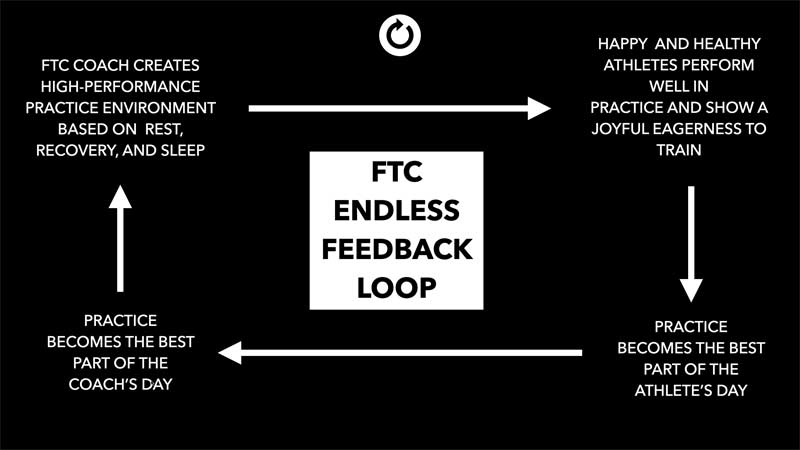Death is required for evolution.
Across 41 years of coaching, my evolution has transformed me into a new coach. For that to happen, many habits, beliefs, and understandings had to die. Things I once believed to be right, I now understand to be wrong. I now vilify those who coach the way I coached in the first half of my career. Growth requires death. My present self grows from the decay of my former self.
By no means do I want to erase my early years of coaching. I wouldn’t be here today if I had not learned from the mistakes I made as a confident and somewhat successful young coach. We all must start before we are the best version of ourselves. It’s said in the business world, “If you are not embarrassed by the first version of your product, you’ve waited too late to launch.” I launched in 1981.
Anyone who has studied evolution understands it’s a slow and gradual process…unless something happens that shakes things up, like an asteroid. My asteroid(s) hit just before the millennium.
The Asteroids
1. “GREAT SEASON, ONE BAD DAY”—Headlines of the Harrisburg Daily Register on June 1, 1998, after my dominant team full of middle distance runners melted in IHSA State Finals.
2. “We had four guys who ran sub-48 in the 400. None of them ever ran more than a 200 in practice”—Paul Souza, coach at D-3 Wheaton College in Norton, MA. Paul Souza’s clinic presentation in St. Louis gave me the courage to coach track in a new way (circa 1999).
3. “I will come to Harrisburg and do a two-day speed camp for $10,000.”—(circa 1999) Don Beebe, one of fastest players to ever play in the NFL.
4. “Dad, I want to play baseball in high school. Track sucks.”—My son Alec, now a track coach, told me this as an eighth grader. If I can’t attract my own son to my sport, what am I doing wrong?
Growth From Those Four Ruptures
1. My track program will focus on sprinting and jumping. Track is a speed-dominant sport. Stop running, start sprinting.
2. My sprinters will never again run a lap in practice. No warm-ups. No cooldowns. We will NEVER run more than 200 meters in practice. Period. Cats don’t jog.
3. What does Don Beebe know that I can’t learn? Just because Don Beebe was fast, does that make him a superior sprint coach? I’m going to run my own damn speed camp, and it’s not going to cost $10,000. (I charged $20 per kid for a two-week camp.)
4. From now on, I will work to make my track program “un-suck.” I will attract cats to my track team. And, from now on, I will “Feed the Cats.”
1999 was my awakening, my epiphany. We won state championships in the 4×1 four times in the next five years. My program attracted our school’s best athletes, and they all got faster. Even more important, they loved track and field. The ninth pillar of Feed the Cats: “Kids are good at what they like, obsessed with what they love.”
In my 41st year, I love coaching track more than ever. I call it “The Endless Feedback Loop,” where a coach creates a high-performance practice environment on a foundation of rest, recovery, and sleep. This creates happy and healthy athletes who show a joyful eagerness to train. Practice becomes the best part of a kid’s day, which makes practice become the best part of a coach’s day. Coaches are then inspired to become better at their craft.

1999 may have been my watershed moment, but I’ve continued to change. I often say that I’ve cooked the same way for 23 years, but my recipes continue to evolve. Good coaches find things they like and add it to their program. Great coaches get rid of nonessentials.
Bob Knight once told me: “Everything you do in practice needs to be evaluated. Does it directly contribute to winning games? If not, get rid of it.” Charlie Francis said, “I think you often have to think about what doesn’t have to be there, rather than what does.” Too many coaches fill their practice time with traditional crap that has no bearing on performance. “Trust the process” they say, even though the process is 50% filler and therefore, should not be trusted.
50 Things I’ve Added or Dropped in the Past 25 Years
1. Added: Timed sprints, 40s, 10-meter flys, 20-yard competition flys, 15-yard block starts into a 10-yard fly, relay zone flys (10-meter into a 20-meter fly), 35-meter flys on the curve, etc.
2. Dropped: Warm-ups and cooldowns.
3. Dropped: Tempo running.
4. Added: Timing systems (Summit-Brower in 2008, Freelap in 2014).
5. Dropped: “Nobody will outwork us.”
6. Added: “Everyone will outwork us.”
7. Dropped: Arbitrary daily intervals. Examples: 15x 150, 12x 200, 10x 300, 8x 400, ladders like 200, 300, 400, 500, 400, 300, 200. (Remember, FTC sprinters don’t run.)
8. Dropped: Crazy stuff like, “Okay, we are going to run ten 400s. For every 400 you run under 60, you get out of one. So, if all 400s are under 60, you only have to do five. And, for every one over 70, you have an extra.”
9. Dropped: All conventional “conditioning” in the off-season. The definition of conditioning is “the process of training or accustoming a person or animal to behave in a certain way or to accept certain circumstances.” Traditional conditioning is the process of getting an athlete accustomed to fatigue, which makes no sense to me.
10. Dropped: All aerobic-focused work, period. From Dr. Jeff Messers: “I conjecture that the accumulation of training from your speed days, lactate workouts, and sprint capacity workouts, for example, is amplifying mitochondrial QUALity (as distinct from mitochondrial QUANtity … the classic metric for assessing endurance or aerobic fitness). There is emerging evidence from accomplished laboratories such as Dr. David Bishop’s laboratory with specific research being guided by current and former Bishop doctoral students such as Cesare Granata providing evidence that high-intensity sprint training may infuse a distinct, specific stimulus to enhance mitochondrial quality … I often refer to the analogy of a bank account and corresponding purchasing power, such as a bank account with a $10 balance. I can increase my purchasing power via (at least) two mechanisms … generate additional bank accounts with a similar $10 balance in each of those new accounts, i.e., 10 accounts w $10 per account yields $100 of purchasing power (analogous to traditional endurance training yielding additional mitochondrial QUANTITY) … OR … I can increase that single account to $100 and thus attain the same purchasing power (analogous to enhanced mitochondrial QUALity).”
11. Added: We do nothing but pure speed and power work in the off-season.
12. Dropped: Unmeasured workouts.
13. Added: All workouts are measured, recorded, ranked, and published.
14. Dropped: High-effort workouts.
15. Added: High-performance workouts.
16. Dropped: Stretching (a stretched rubber band doesn’t shoot as far).
17. Added: Be-Activated and then the next generation, Reflexive Performance Reset.
18. Dropped: Shaming athletes into practicing in spite of discomfort and soreness (man-up!). Too many kids get broken by coaches. I only train happy and healthy athletes; it’s non-negotiable.
19. Added: “Health trumps all workouts.” Pillar #6 of Feed the Cats: “I’d rather have athletes who are 100% healthy and 80% in shape than the other way around.” (Quote by Harry Marra)
20. Dropped: “In shape” from my vocabulary.
21. Added: “Tired is the enemy.”
22. Added: “Never let today ruin tomorrow” or its complete version, “Never let today’s workout ruin tomorrow’s workout.” Even better, “Don’t burn the steak.”
23. Dropped: 30-meter block starts (causes athletes to rush acceleration).
24. Added: 15-yard block starts into a 10-yard fly (teaches patient acceleration).
25. Dropped: Back-to-back meets. I intuitively thought having a back-to-back meet would prepare us for the back-to-back prelims and finals at our state meet. Back-to-back meets are a disaster. We have always performed great on the second day of the state meet; there’s no need to suffer through back-to-back meets to prepare. The state meet is the hardest thing we do all year, and that’s okay.
I dropped back-to-back meets. Back-to-back meets are a disaster. We have always performed great on the 2nd day of the state meet; there’s no need to suffer through back-to-back meets to prepare. Share on X
26. Dropped: Making practices harder than track meets. My dad, a high school and college basketball coach for 47 years, used to say, “We are going to practice so hard that games will feel easy.”
27. Added: Let the track meet be the hardest thing we do.
28. Dropped: The idea that track practice has a daily format: warm-up, stretch, run intervals, and then do a cooldown.
29. Added: Color-coded practices: Yellow (caution) is a speed day or an X-factor day; red (danger) is a lactate workout, sprint capacity workout, or a meet; and green (renewal) is an off day. Off days typically make up over 40% of my season calendar!
30. Added: No more than two “red days” per week (meets or lactate workouts).
31. Added: No more than three sprint days per week (speed workouts, lactate workouts, sprint capacity workouts, and meets).
32. Added: Green always follows red.
33. Added: The idea of an X-Factor workout. I coined the phrase “X-Factor” in 2006. “X-Factor” was not a new term, but it was a new term for a workout. If we only sprint a maximum of three times a week, what do we do on non-sprint days? “X” in science stands for unknown. X-Factor workouts are exercises that may improve speed. X-Factor exercises are low-dose (color code yellow). We do hip mobility, plyometrics, big split drills, angular velocity drills, wickets, force absorption, strength work, block fundamentals, handoff fundamentals, etc. We vary the drills as much as possible and experiment every week. And athletes have no idea what’s coming.
34. Dropped: The idea that we must practice after school every day.
35. Added: “Sprint holidays” after meets and lactate workouts. Once, a kid asked why the d-crew and throwers still had to practice. My answer, “Because you guys aren’t fast enough to be sprinters.” No one has asked since.
36. Added: The preferred number of workdays per week is four and never more than five. My evolution on work weeks has gone from six to five to four. By the time I’m 70, that number may be three!
37. Added: The “Bang Step.” After my IL #2 4×1 team botched a handoff in the 2016 prelims (will haunt me forever), I decided to create something that defined “go” for the outgoing runner, something verifiable by video… something that would prevent anyone from ever leaving early, ever again. The Bang Step has been a game-changer. We have not left early in a 4×1 since.
38. Added: Twitter. Sounds crazy, but Twitter changed my life in 2013. Nine years later, I’m in daily contact with some of the smartest coaches on the planet. In addition, I tell my team they are “America’s Team.” Not many high school track coaches promote their team to 21K followers.
39. Dropped: Bulletin boards and emails. Twenty years ago, I promoted my team in the main hallway at Harrisburg High School, across from the principal’s office. I also emailed meet write-ups to nearly 300 people.
40. Added: pntrack.com.
41. Added: The 23-Second Drill. When I first attended a clinic to listen to Chris Korfist in 2008, I knew what lactate was. I majored in biology in college. Lactic acid was the by-product of glycolysis and was quickly converted into lactate and hydrogen ions. However, I didn’t understand lactate in a training sense. Knowing the answers to the test on energy systems is totally different than applying that knowledge to training.
Chris Korfist talked about how lactate levels are at the highest eight minutes after sprinting for 23 seconds. When an athlete attempts their second run eight minutes after the first, they are polluted with lactate. Me being a science teacher (Chris teaches history) helped to explore the concept further. It’s not the lactate that pollutes, it’s the acidity (the hydrogen ions). Lactate is measurable, but its acidity makes you dizzy, blurs your vision, and makes you want to lie in the fetal position thinking you might die. The 23-Second Drill is now done all over the world. Chris invented it; I wrote about it.
42. Added: The 4×4 Predictors. With my new understanding of glycolysis, lactate, and acidosis in regard to long sprints, I created my 4×4 Predictors. Like the 23-Second Drill, the 4×4 Predictors create biochemical toughness without high volumes. The workout is like a terrible pill that has an incredible impact. Like the 23-Second Drill, the 4×4 Predictors are now used by coaches everywhere. Some people think the “prediction” is the reason for the drill, and they can’t be more wrong. Biochemical toughness is the reason for the drill. The “prediction” simply adds meaning and significance to the workout. Our guys PERFORM.
43. Dropped: 20 x 100 yards in 20 minutes. This was my go-to workout for bad weather. Only 20 minutes in the cold, rain, and wind. No warm-up. Just line up on the goal line and run a 14- to 15-second 100 yards then get ready to run the next one at the minute mark. Fifteen seconds of running was followed by 45 seconds of recovery. But that’s TEMPO WORK. Now on those awful days, we go inside and do X-Factor or take the day off. Haven’t done 20 x 100 in 10 years.
44. Dropped: Blind handoffs in the 4×200. We now do open handoffs.
45. Added: Sprint capacity workouts once or twice a year. My two sprint capacity workouts are 10 x 40m fly in 10 minutes or the Freelap 500 (5 x 100m fly with a two-minute walk-back recovery).
46. Added: A Canon 7D Mark II with Canon EF 85mm f/1.8 fixed lens. My camera promotes our sport and makes track meets and track athletes look better than they really are.
47. Added: A focus on dopamine. Dopamine is a neurotransmitter that allows us to move our arms and legs fast and gives us reckless confidence. It’s the food of cats. How do we increase dopamine? Sleep, sunshine, and winning. (Never underestimate the best motivator in the world—success.)
48. Added: A focus on sleep. Only in recent years have I started blaming almost everything on poor sleep. As a younger coach, I was more focused on nutrition. Now, I believe sleep is king. Why are my times stagnant? Not enough sleep. Why am I sore? Not enough sleep. Cats sleep 20 hours a day.
49. Dropped: The old, worn-out tradition of a 400-meter focus. Old school coaches believed that God made fast guys and coaches made quarter-milers. They trained everyone in the middle (intervals) and simply prescribed more and longer intervals for the distance runners. And, of course, those coaches would curse the gods of fate for not providing them with more sprinters. Traditional track coaches detrained speed and bitched about having no sprinters. It’s like the Chris Knight line, “I shoot out the lights, and I curse the dark.” I wish I had a dime for every time I’ve heard, “But we don’t have any cats!”
50. Added: A new focus: miles per hour. Give me six guys who can run 23 miles per hour, and I will guarantee a state championship. Give me guys that can run 23 mph and watch us excel in the 400. Give me guys that run 23 mph and marvel at how good we are in the hurdles and jumps. Speed is the KPI of track and field. Feed the Cats!
Since you’re here…
…we have a small favor to ask. More people are reading SimpliFaster than ever, and each week we bring you compelling content from coaches, sport scientists, and physiotherapists who are devoted to building better athletes. Please take a moment to share the articles on social media, engage the authors with questions and comments below, and link to articles when appropriate if you have a blog or participate on forums of related topics. — SF






